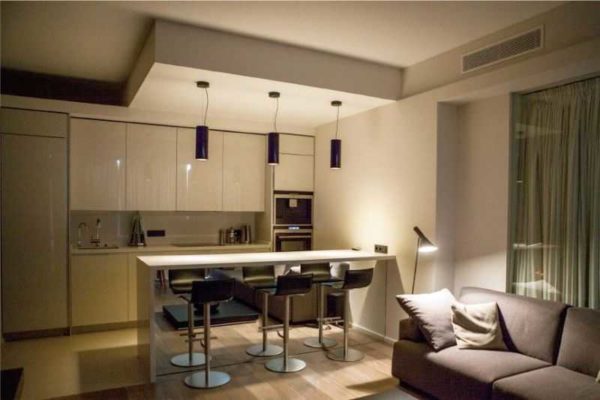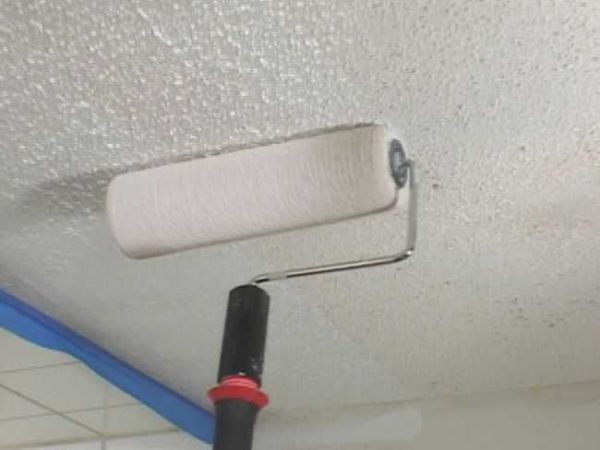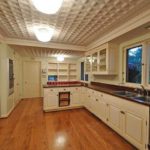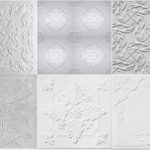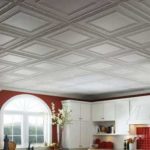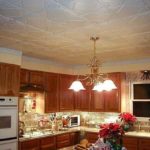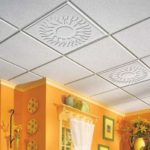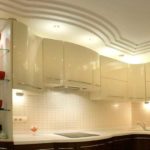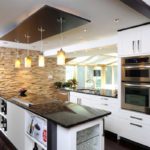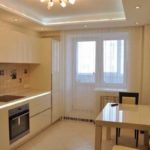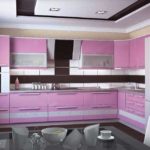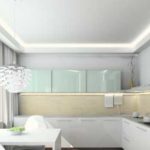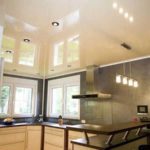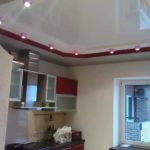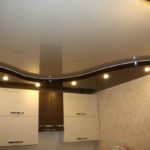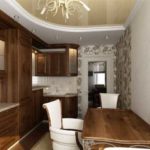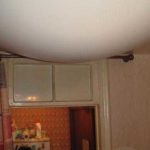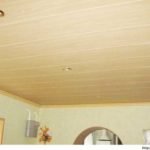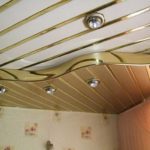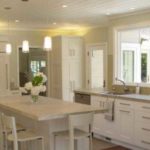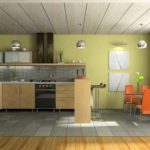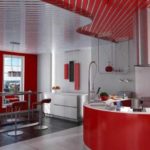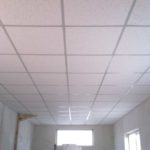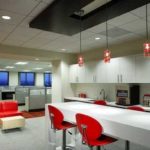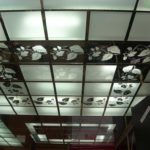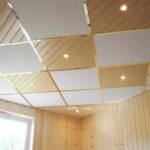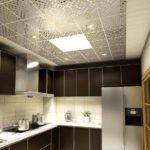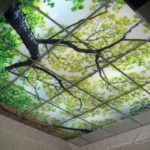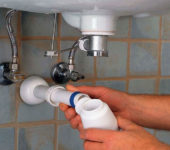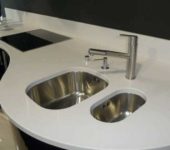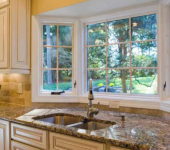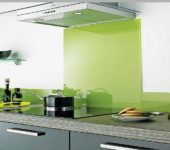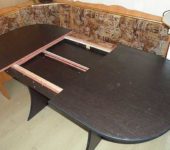What to make a ceiling in the kitchen
Decorating a kitchen is a daunting task. It should be practical, comfortable, beautiful and desirable - not very expensive. And one of the tasks that have to be solved is to choose which ceiling to make in the kitchen so that it is easy to use, lasts a long time and is still attractive.
The content of the article
Requirements for kitchen ceilings
The kitchen is a room with difficult operating conditions. High humidity, an abundance of pollutants, in apartments - a high probability of flooding. All this imposes certain requirements on finishing materials. In particular, the ceiling in the kitchen must have the following characteristics:
- Easy care, the ability to wash with detergents.
- Normal reaction to high humidity.
- Durability, high maintainability.
- Safety from the point of view of ecology and fire safety.
- Attractive appearance.
- Low price and ease of installation.
In addition to all that has been said, there is one more wish - it’s not bad if the ceiling in the kitchen makes it possible to hide engineering networks (ventilation, wiring) and floor flaws.
Unfortunately, even with the current abundance of finishing materials, the whole complex of requirements is not combined in any of them, but there are very good options.
Whitewashing, painting
Some time ago, all our ceilings were whitewashed. Because this type of decoration costs mere pennies, the material is widespread, the whitewashing process itself did not present any difficulties and almost everyone whitewashed the ceilings on their own.
Another advantage of this method of finishing the flow in the kitchen is the ability of lime to regulate humidity. With an excess of moisture in the air, it absorbs it, with a lack of moisture, it gives. Excellent quality for the kitchen. This is where the pros end.
The disadvantages of whitewashing the ceiling are also significant. The first disadvantage is not the most attractive look. Second, the surface is porous, except for moisture, it absorbs odors. Drops of fat or coloring liquids that fall on the surface are absorbed into the material, after which they are not removed in any way. Only painted over with a new layer or two of lime. It is for these reasons that whitewashing in the kitchen is now becoming less common.
Painting the ceiling in the kitchen is a modern replacement for whitewash. For these purposes, water-based paints with increased washable ability are most often used. With normal preparation of the ceiling, the appearance is at least normal. The operational properties are also improved - the painted ceiling in the kitchen can be washed several times using liquid detergents.
The main disadvantage of this option is the need for careful preparation of the surface for painting. In order for the painted shelf to look good, it must be smooth and flawless. Level it first with plaster, then, in several layers, with putty. The process is not easy, lengthy, and costly.
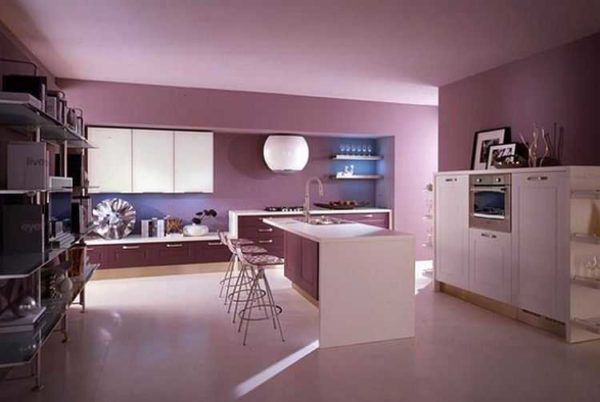
In order for the painted ceiling in the kitchen to look like this, careful surface preparation is needed.
Wallpaper for painting helps to make preparing the ceiling for painting a little easier. The ceiling also needs to be leveled, but not to the same extent as for applying paint. For these purposes, there are special fiberglass, non-woven, paper. The most durable are fiberglass. They can be repainted up to 20 cuts. Paper ones serve least of all. They can withstand 2-3 repaints. Non-woven are a good option both in quality and in price. They will also delight you with a rich selection of ornaments (if you want, of course).
Another drawback of painted ceilings is that when leaking, there are stains that can only be painted over. It is rarely possible to paint only the damaged part - different shades are obtained. We have to paint the entire ceiling entirely.
Ceiling tiles
If you don't know how to make a ceiling in the kitchen so that it is inexpensive and fast, consider a tile made of foam or polystyrene. This method is now far from being as popular as 10 years ago, but it is still used when there is a lack of funds and / or time for other types of finishes.
Ceiling tiles in the kitchen are a good option. It is washable with a brush and non-abrasive liquid detergents. Ceiling tiles are glued with special glue. The base is preferably flat, without sharp drops, but a perfect surface is not required. Installation takes several hours, and you immediately get a ready-to-use ceiling.
- It looks like a PVC tile on the ceiling - one of the options
- Several types of ceiling tiles
- For a classic-style kitchen, this option is suitable.
- To create a cozy atmosphere
- There are smooth slabs, there are with ornaments
There are few disadvantages. First, not everyone likes the look. Here you can agree or not - a matter of taste. The material is not fancy, but the result is quite decent. Especially if you need an inexpensive finishing method.
The second minus is unnatural material. You cannot argue with this, but the material used - polystyrene - is chemically neutral and does not emit any substances in a normal state. Neither harmful nor beneficial. And that's not bad either.
Drywall
If you can make a ceiling in the kitchen by lowering it a few centimeters, consider a plasterboard suspended ceiling. This method of finishing the ceiling is good because you can make multi-level structures that completely cover the ceiling. In the gap between the main and false ceilings, you can lay communications - a helicopter box, wiring.
Ceiling design allows installationSpotlightsby choosing a place to place them to your liking, which makes lighting in the kitchen more functional. The result can be very beautiful. Another positive point is that the drywall is made from natural materials - two sheets of cardboard and a layer of gypsum between them.
- Plasterboard can be used to make multi-level ceilings
- The design can be in different styles
- Competent illumination makes even an ordinary ceiling beautiful
- Complex designs can be created
- Perfect finish quality
Installation of plasterboard ceiling - the task is difficult. First, the frame is assembled from the guides, then it is sheathed with plasterboard, then putty and painted. The good news is that drywall putty it is several times easier to level the base ceiling: the surface is initially even, only the joints need to be repaired, and then, with a thin layer of putty, cover the entire surface.
The disadvantage of a plasterboard ceiling in the kitchen is the difficulty in leaving. Even if you use a moisture resistant water-based paint, the surface will remain rough. Soot is clogged in the pores, dust is mixed with fat. Removing this plaque is not easy at all. Another disadvantage is that drywall does not react well to water. If you use a moisture-resistant material, it will not be afraid of high humidity, but if it is flooded from above, most likely everything will have to be redone.
Stretch ceiling
Stretch ceiling in the kitchen is a good choice. In any case, beautiful and modern. Although, during their construction, it will again be necessary to "take away" a certain volume: they are mounted at some distance from the ceiling. As in the case of plasterboard streams, stretch streams also allow you to hide the base ceiling and utilities. Spotlights can also be used for lighting, but of a different design.
Stretch ceilings are film (their PVC films) and fabric. For the kitchen, it is worth choosing film. They are smooth, which is easier to clean, and can be glossy, which makes the room brighter and adds volume. If you decide to make a stretch ceiling in the kitchen from PVC film, protection against flooding will be an additional bonus, since the film is absolutely waterproof. If you are flooded by the neighbors from above, the water will collect as if in a sack. It will need to be carefully poured, after which the material will return to its normal size.
- Don't know what kind of ceiling to make in the kitchen? Maybe a stretch one?
- Light shine on the ceiling makes the room visually higher
- Shape and color - any
- Styles can also be different
- This is after the flood - the water gathered in one place
The disadvantage of a film ceiling is its chemical origin and the ability to change dimensions from a sharp change in temperature. The film may wrinkle, sag, etc. Not the highest quality canvases suffer from this, but such a phenomenon is present. Another significant drawback is that if you touch the film ceiling with a sharp object, the hole will be very large. The material is tightly stretched, because of which the slightest puncture turns into a huge hole. Tissue tension streams are devoid of this drawback, but they are looser in structure, it is more difficult to care for them, they are permeable to water. But the hole made by accident does not increase.
The disadvantages also include the high price and complexity of installation, although if you wish, you can handle it yourself. If a heat gun or its substitute is required for the installation of a film ceiling (to warm up the canvas), then nothing is needed for a fabric ceiling.
Plastic panels
If you are looking for what kind of ceiling to make in the kitchen so that it is inexpensive and easy to clean - your choice is plastic panels. This material costs quite a bit, you can wash it with a rag using liquid detergents. The surface is usually smooth, everything is easy to clean.
Plastic panels for the ceiling quickly and easily installed in the kitchen. A starting plinth is attached along the perimeter, panels cut to size are inserted into it. It also takes a few centimeters of height and makes it possible to hide communications, you can use spotlights. An additional plus is its high maintainability. If something happened to one or more planks, you can remove them, install whole ones in their place.
- The easiest option is the slats are fitted to one another
- You can also make two-level ceilings from plastic panels.
- It looks quite decent
- Material flaws can always be played up so that they turn into a highlight of the interior
- Another option for a non-standard approach
Also, this type of ceiling finish allows you to quickly get to the base ceiling or those systems that it hides. This is a useful property.
Disadvantages - not the best look and fragility of the panels. But the load on the ceiling is usually small, so plastic ceiling panels serve until the owners want something else. Another disadvantage is an unnatural material that emits harmful substances when burned.
False ceiling armstrong
If they find out what kind of ceiling to make in the kitchen, they rarely remember this type. Armstrong is more often used in offices, salesrooms, industrial premises, but in houses and apartments he also shows himself well. It is inexpensive, easy to install, made of natural materials, and has high maintainability.
False ceiling Armstrong is a system of profiles arranged in the form of squares. Plates are inserted into the squares, which form the plane of the ceiling. The boards are simply laid on the profiles and are not fixed with anything. It is convenient: damaged slabs can be easily replaced; there is always access to the ceiling space.
- The easiest option
- What kind of ceiling to make in the kitchen so that it is inexpensive, but beautiful - armstrong
- The filling can be glass
- You can fill the squares with any suitable material
- This is already an expensive option.
- Photo printing on glass. And this too - Armstrong suspended ceilings
The disadvantage of the system is that it takes away the height from the room, the plates are afraid of water (this is pressed and colored paper). And the traditional drawback for inexpensive ways to decorate the ceiling in the kitchen is not a very cozy look, although not everyone will agree with this.
Only profiles can be washed, plates cannot. But they can be repainted or replaced with new ones - the cost is small, the replacement process will take an hour or two (taking into account pruning). In general, a good budget option for repairing the ceiling.

